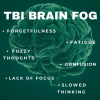Individuals with traumatic brain injuries can experience a variety of symptoms such as physical, cognitive, and emotional changes that significantly impact their lives. As a result, survivors may exhibit personality changes, memory problems, seizures, sleep disorders, chronic pain, tremors, vision problems, and other disabling symptoms that can affect their quality of life. This can lead to feeling hopeless, chronic anxiety or depression, and relationships to breakdown, making survivors more susceptible to having suicide attempts.
Research has found that traumatic brain injury survivors, which includes civilian and military population, had an increased suicide risk compared to the general population.
According to the Centers for Disease Control and Prevention, approximately 97 percent of traumatic brain injuries are the result of a firearm each year. A 2018 retrospective cohort study that examined over 7 million patients over 10 years old in Denmark from 1980 to 2014, found the risk of suicide higher is doubled for patients with a traumatic brain injury including concussions, and even higher for a severe traumatic brain injury, numerous medical visits, and longer hospital stays. Additionally, there is an increased risk during the first six months post-injury.
The correlation between suicide after a brain injury is speculated to be due to psychiatric conditions that arise after a TBI. Other studies have found similar traits between TBI and suicidal ideation such as bipolar disorder, depression, dysthymia (persistent depressive disorder), anxiety disorders, substance abuse and perceived burdensomeness. While survivors who have a prior history of suicidal ideation have an increased risk, survivors without a history are still significantly vulnerable of suicidal ideation. Lastly, it is important from various research studies, veterans who sustained a traumatic brain injury are twice as likely to commit suicide than veterans without a TBI.
Learning about suicide prevention is crucial along with educating health care professionals and the community to identify the risk factors and signs of suicidal ideation. Preventative strategies can include teaching problem-solving skills and promoting connectedness among each other.
| Shared Risk Factors for Traumatic Brain Injury Survivors and Suicide | Warning Signs (in addition to risk factors) |
|
|
Strategies
|
Resources
|
References:
Madsen, T., Erlangsen, A., Orlovska, S., Mofaddy, R., Nordentoft, M., & Benros, M. E. (2018). Association Between Traumatic Brain Injury and Risk of Suicide. JAMA: Journal of the American Medical Association, 320(6), 580–588. https://doi-org.westcoastuniversity.idm.oclc.org/10.1001/jama.2018.10211
Miller, G. F., Kegler, S. R., & Stone, D. M. (2020). Traumatic Brain Injury–Related Deaths From Firearm Suicide: United States, 2008–2017. American Journal of Public Health, 110(6), 897–899. https://doi-org.westcoastuniversity.idm.oclc.org/10.2105/AJPH.2020.305622
Bryson, C. N., Cramer, R. J., & Schmidt, A. T. (2017). Traumatic brain injury and lifetime suicidality: Applying the interpersonal-psychological theory perspective. Death Studies, 41(7), 399–405. https://doi-org.westcoastuniversity.idm.oclc.org/10.1080/07481187.2017.1320340
Mental Illness Research Education Clinical, Centers of Excellence (MIRECC). 2013. Conceptualizing Suicide Risk in TBI. VA Rocky Mountain Network. www.mirecc.va.gov/visn19/docs/conceptualizing_suicide_risk_in_tbi.pdf
National Institute of Mental Health. (n.d.) Warning Signs of Suicide. https://www.nimh.nih.gov/health/publications/warning-signs-of-suicide/index.shtml
Suicide Prevention Resource Center. (n.d.) A Comprehensive Approach to Suicide Prevention. https://www.sprc.org/effective-prevention/comprehensive-approach



